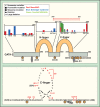Master regulatory GATA transcription factors: mechanistic principles and emerging links to hematologic malignancies
- PMID: 22492510
- PMCID: PMC3401466
- DOI: 10.1093/nar/gks281
Master regulatory GATA transcription factors: mechanistic principles and emerging links to hematologic malignancies
Abstract
Numerous examples exist of how disrupting the actions of physiological regulators of blood cell development yields hematologic malignancies. The master regulator of hematopoietic stem/progenitor cells GATA-2 was cloned almost 20 years ago, and elegant genetic analyses demonstrated its essential function to promote hematopoiesis. While certain GATA-2 target genes are implicated in leukemogenesis, only recently have definitive insights emerged linking GATA-2 to human hematologic pathophysiologies. These pathophysiologies include myelodysplastic syndrome, acute myeloid leukemia and an immunodeficiency syndrome with complex phenotypes including leukemia. As GATA-2 has a pivotal role in the etiology of human cancer, it is instructive to consider mechanisms underlying normal GATA factor function/regulation and how dissecting such mechanisms may reveal unique opportunities for thwarting GATA-2-dependent processes in a therapeutic context. This article highlights GATA factor mechanistic principles, with a heavy emphasis on GATA-1 and GATA-2 functions in the hematopoietic system, and new links between GATA-2 dysregulation and human pathophysiologies.
Figures


References
-
- Yamamoto M, Ko LJ, Leonard MW, Beug H, Orkin SH, Engel JD. Activity and tissue-specific expression of the transcription factor NF-E1 multigene family. Genes Dev. 1990;4:1650–1662. - PubMed
-
- Dorfman DM, Wilson DB, Bruns GA, Orkin SH. Human transcription factor GATA-2. Evidence for regulation of preproendothelin-1 gene expression in endothelial cells. J. Biol. Chem. 1992;267:1279–1285. - PubMed
Publication types
MeSH terms
Substances
Grants and funding
LinkOut - more resources
Full Text Sources
Other Literature Sources
Research Materials

